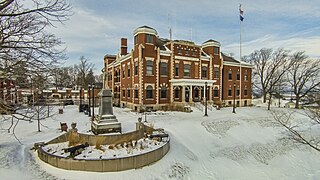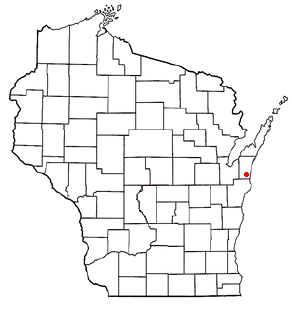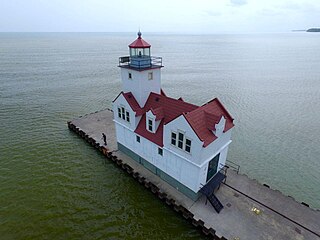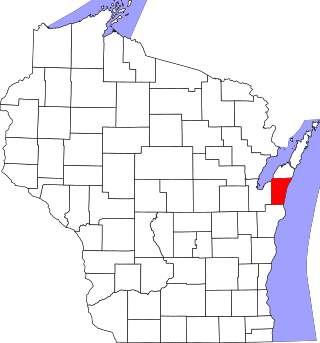
Kewaunee County is a county located in the U.S. state of Wisconsin. As of the 2020 census, the population was 20,563. Its county seat is Kewaunee. The county was created in 1852 and organized in 1859. Its Menominee name is Kewāneh, an archaic name for a species of duck. Kewaunee County is part of the Green Bay, WI Metropolitan Statistical Area as well as the Green Bay-Shawano, WI Combined Statistical Area.

Door County is the easternmost county in the U.S. state of Wisconsin. As of the 2020 census, the population was 30,066. Its county seat is Sturgeon Bay.

Carlton is a town in Kewaunee County, Wisconsin, United States. The population was 1,014 at the 2010 census. Carlton is probably named for James Carlton, an early settler in the area.

The brown trout is a species of salmonid ray-finned fish and the most widely distributed species of the genus Salmo, endemic to most of Europe, West Asia and parts of North Africa, and has been widely introduced globally as a game fish, even becoming one of the world's worst invasive species outside of its native range.
Peter Pond was an American explorer, cartographer, merchant and soldier who was a founding member of the North West Company and the Beaver Club. Though he was born and died in Milford, Connecticut, most of his life was spent in northwestern North America, on the upper Mississippi and in western Canada.

Leland is an unincorporated community and census-designated place (CDP) in the U.S. state of Michigan. It is located in Leelanau County, part of the northwestern Lower Peninsula of the state. As of the 2020 census it had a population of 410. From 1883 to 2004, Leland was the county seat of Leelanau County, which has since moved to Suttons Bay Township.

The Chinook salmon is the largest and most valuable species of Pacific salmon. Its common name is derived from the Chinookan peoples. Other vernacular names for the species include king salmon, Quinnat salmon, Tsumen, spring salmon, chrome hog, Blackmouth, and Tyee salmon. The scientific species name is based on the Russian common name chavycha (чавыча).

Lake Oroville is a reservoir formed by the Oroville Dam impounding the Feather River, located in Butte County, northern California. The lake is situated 5 miles (8 km) northeast of the city of Oroville, within the Lake Oroville State Recreation Area, in the western foothills of the Sierra Nevada. Known as the second-largest reservoir in California, Lake Oroville is treated as a keystone facility within the California State Water Project by storing water, providing flood control, recreation, freshwater releases to assist in controlling the salinity intrusion into the Sacramento-San Joaquin Delta and protecting fish and wildlife.

The Door Peninsula is a peninsula in eastern Wisconsin, separating the southern part of the Green Bay from Lake Michigan. The peninsula includes northern Kewaunee County, northeastern Brown County, and the mainland portion of Door County. It is on the western side of the Niagara Escarpment. Well known for its cherry and apple orchards, the Door Peninsula is a popular tourism destination. With the 1881 completion of the Sturgeon Bay Ship Canal, the northern half of the peninsula became an island.

The round whitefish is a freshwater species of fish that is found in North American drainages from Alaska to New England, including the Great Lakes except for Lake Erie, and in Arctic tributaries of northeast Asia, as well as northern Kamchatka Peninsula and the northern coasts of the Sea of Okhotsk. It has an olive-brown back with light silvery sides and underside and its length is generally between 9 and 19 inches. They are bottom feeders, feeding mostly on invertebrates, such as crustaceans, insect larvae, and fish eggs. Some other fish species, like white sucker in turn eat their eggs. Lake trout, northern pike and burbot are natural predators. Other common names of the round whitefish are Menominee, pilot fish, frost fish, round-fish, and Menominee whitefish. The common name "round whitefish" is also sometimes used to describe Coregonus huntsmani, a salmonid more commonly known as the Atlantic whitefish.

The rainbow smelt is a North American species of fish of the family Osmeridae. Walleye, trout, and other larger fish prey on these smelt. The rainbow smelt prefer juvenile ciscoes, zooplankton such as calanoid copepods, and other small organisms, but are aggressive and will eat almost any fish they find. They are anadromous spring spawners and prefer clean streams with light flow and light siltation. The rainbow smelt face several barriers. They are weak swimmers and struggle to navigate fish ladders preventing them from making it past dams to the headwater streams where they spawn. The rise in erosion and dams helped to decimate the smelt population in the 1980s. There are currently plans to try to reduce damming and to help control erosion.

The longnose sucker is a species of cypriniform freshwater fish in the family Catostomidae. It is native to North America from the northern United States to the top of the continent. It is also found in Russia in rivers of eastern Siberia, and this one of only two species of sucker native to Asia.

The Kewaunee Pierhead lighthouse is a lighthouse located near Kewaunee in Kewaunee County, Wisconsin. The lighthouse looks nearly identical to the Holland Harbor Lighthouse, except that it is colored white.

The Sandy Lake Tragedy was the culmination in 1850 of a series of events centered in Big Sandy Lake, Minnesota that resulted in the deaths of several hundred Lake Superior Chippewa. Officials of the Zachary Taylor Administration and Minnesota Territory sought to relocate several bands of the tribe to areas west of the Mississippi River. By changing the location for fall annuity payments, the officials intended the Chippewa to stay at the new site for the winter, hoping to lower their resistance to relocation. Due to delayed and inadequate payments of annuities and lack of promised supplies, about 400 Ojibwe, mostly men and 12% of the tribe, died of disease, starvation and cold. The outrage increased Ojibwe resistance to removal. The bands effectively gained widespread public support to achieve permanent reservations in their traditional territories.
Rough fish is a term used by some United States state agencies and anglers to describe fish that are less desirable to sport anglers within a defined region. The term usually refers to larger game fish species that are not commonly eaten, are too rare to be commonly encountered, or are not favorably sought by anglers for sporting purposes. Many of these species are actually very important in the commercial fishing industry, where they make up the bulk of commercial food fish catches in inland freshwater bodies.
The Kewaunee River is a 27.9-mile-long (44.9 km) river in the U.S. state of Wisconsin. It begins near Frog Station in northwest Kewaunee County and flows southeast to empty into Lake Michigan at the city of Kewaunee.
The Bay-Lakes Council is the Boy Scouts of America (BSA) council serving eastern Wisconsin and the Upper Peninsula of Michigan. Headquartered in Appleton, Wisconsin, it is geographically one of the largest local BSA councils. Bay-Lakes Council #635 was formed on July 1, 1973, the product of a merger between six east Wisconsin councils. The council is served by Kon Wapos Lodge of the Order of the Arrow.

This is a list of the National Register of Historic Places listings in Kewaunee County, Wisconsin. It is intended to provide a comprehensive listing of entries in the National Register of Historic Places that are located in Kewaunee County, Wisconsin. The locations of National Register properties for which the latitude and longitude coordinates are included below may be seen in a map.

The lake chubsucker is a species of freshwater fish endemic to North America, found in the Great Lakes and the Mississippi River basin, as far north as Ontario, Canada, extending south to the Gulf of Mexico. It is mainly found in lakes, ponds, and swamps, rarely in streams.
The Besser Museum for Northeast Michigan is a community museum serving Alpena County and surrounding counties in the U.S. state of Michigan. Alpena is a port city on Lake Huron. The museum defines its role broadly — to preserve, protect and present history and culture closely connected with the heritage of Northern Michigan and the Great Lakes. The museum includes a small publicly-owned planetarium.














